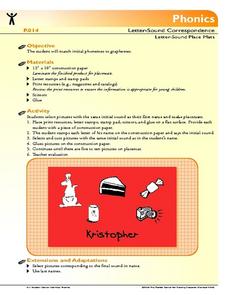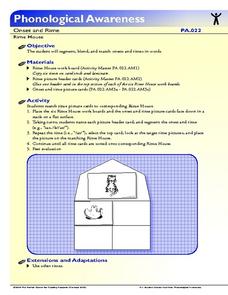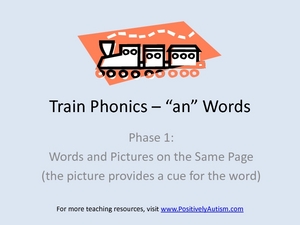Florida Center for Reading Research
Phonics: Letter-Sound Correspondence, Letter-Sound Place Mats
Young scholars create personalized place mats as they learn about initial sounds. Using construction paper, they stamp their names using letter stamps. Scholars examine print resources and cut out pictures with the same initial sound as...
Florida Center for Reading Research
Phonics: Letter-Sound Correspondence, Letter-Sound Bingo
Young scholars build a strong understanding of medial sounds, vowels, and letter sound correspondence while playing Bingo. Taking turns, peers choose a card and say its name and medial sound; all players look for the vowel on their card....
Florida Center for Reading Research
Phonics: Letter-Sound Correspondence, Letter-Sound Folder Sort
Practice letter-sound correspondence using an activity that challenges pupils to sort images based on their final sounds. Pairs choose four final sounds to place in an open file folder, take turns selecting image cards, pronouncing the...
Florida Center for Reading Research
Phonological Awareness: Onset and Rime, Rime House
Are you covering onset and rime with budding readers? Here, learners examine six "rime house" work boards, each with an image at the top. Working with a partner, they segment each top image's onset and rime. Then, they pick cards and...
Florida Center for Reading Research
Phonics: Letter-Sound Correspondence, Letter-Sound Mobile
Get creative with phonics by having kids create a letter-sound mobile! Learners practice matching medial sounds to their corresponding vowels using a hanger, hole punch, string, and the provided image and letter cards. Students attach...
Florida Center for Reading Research
Phonological Awareness: Rhyme, Rhyme or No Rhyme
Rhyming is fun, builds phonemic awareness, and is a tried and true pre-reading skill. This activity helps learners identify words that rhyme. Young scholars listen to a song, locate a rhyming word they hear by clapping then draw a...
Florida Center for Reading Research
Phonics: Letter-Sound Correspondence, Words Around Us Memory Game
Scholars employ memory and letter-sound skills like the classic game Concentration to succeed at this literacy game. Partners choose from rows of upside-down cards, trying to match letters to images with the corresponding initial sound.
Florida Center for Reading Research
Phonics: Letter-Sound Correspondence, Medial Phoneme Spin
A collaborative activity challenges young scholars to match medial graphemes and phonemes. Pairs take turns spinning the spinner, naming the letter, and saying its name. They choose from a stack of cards with the same medial sound.
Florida Center for Reading Research
Phonics: Letter-Sound Correspondence, Letter-Sound Match
Boost initial, medial, and final sound correspondence. Scholars practice decomposing word sounds using image cards and a worksheet. Learners cut out 10 three-letter images, sound them out, and glue them on the worksheet. Each word is...
Florida Center for Reading Research
Fluency: Letter-Sound Correspondence, Letter Flash
Scholars work in pairs to drill and practice alphabet sounds, keeping track of their progress on a chart. Working one at a time, each partner flips letter cards, saying the sound and letter. If they get it correct, it goes in the YES...
Florida Center for Reading Research
Phonics: Letter-Sound Correspondence,
What a fun way to practice medial sound-letter correspondence! This alphabet activity has pupils flip cards, determine the medial sound, and place it on one of the train cars if it matches.
Florida Center for Reading Research
Phonics: Letter- Sound Correspondence, Brown Bag It
Sorting objects according to their initial sound get scholars thinking about letter-sound correspondence. With 26 brown bags labeled with a letter of the alphabet, learners browse magazines and cut out images that begin with the...
Florida Center for Reading Research
Phonics: Letter-Sound Correspondence, Where's That Sound?
The phoneme train is leaving the station! Get your budding readers familiar with letter-sound correspondence using this fun phonics activity. Learners set up the initial and final sound train cards, placing letters between them. They...
Florida Center for Reading Research
Phonics: Letter Recognition, Lettercritter
This is a fun idea to get your scholars practicing their ABCs! They assemble an alphabet caterpillar, printing lowercase versions below each uppercase letter. They practice writing the lowercase letters using dry-erase markers and say...
Curated OER
Shall We Practice More Phonemes?
A simple presentation designed for emerging readers. Learners practice saying the sounds that a variety of phonemes produce. As the slides go on, the phonemes are combined to make actual words. Good practice for the young ones!
Florida Center for Reading Research
Recognizing Letters
Boost letter recognition with an activity that challenges young scholars to match a plastic letter to one printed on a card.
Curated OER
Phonics Train: /at/ words
A well-scaffolded phonics resource awaits you and your autistic learners. Phase one in this multi-page document asks, "What is on the train?" The answer is an /at/ word, such as cat, mat, bat, or hat. In Phase two, the train is shown...
Curated OER
Train Phonics - /an/ Words
Follow the phonics train and get your special needs class on the reading track. To promote the /an/ sound and phonemic awareness, each page contains an image of a train, and each car contains an item. The word representing that item is...
Florida Center for Reading Research
Phonics: Letter Recognition, Clip-A-Letter
Young scholars show what they know about the alphabet. With two circles—one surrounded by capital letters and one with lowercase—pupils use clothespins to match letters, case to case or the opposite.
Florida Center for Reading Research
Phonological Awareness - Phoneme Segmenting and Blending, Treasure Chest
Working in pairs, scholars use picture cards to practice segmenting words into phonemes and blending phonemes into words. When a peer answers correctly they place a penny in a treasure chest. Incorrect responses make the card go back in...
Curated OER
Long Vowel Sounds
Build reading skills, phonemic awareness, or spelling strategies with this super handy presentation. Each slide contains several variations of a long vowel sound and multiple examples of each. This is a great tool to have around,...
Curated OER
Lights, Camera, and Action!
These activities center around acting out a play to help create fluent readers who use expression and emotion. As readers work through the play the first time, they also practice decoding strategies. In small groups of four, they then...
Curated OER
Reading Phonetically: /an/ words
What do the words van, man, and pan have in common? The /an/ sound! Reinforce this target sound with this resource, intended for an audience with autism or other special needs. Your learners will see an image and the corresponding word,...
Curated OER
Using the Sounds of Words Reading Task
Young readers demonstrate phonemic awareness in words and blends, and recognize 100 high-frequency words. Use a nursery rhyme to point out rhyming words, and change the words by putting a new letter at the beginning. Each learner will...

























